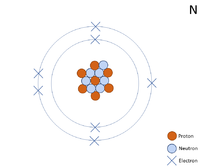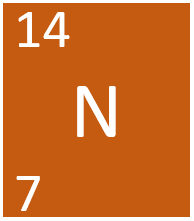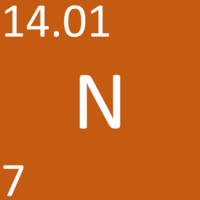Difference between revisions of "Nitrogen"
(→Properties) |
|||
| (12 intermediate revisions by 2 users not shown) | |||
| Line 4: | Line 4: | ||
==Key Stage 3== | ==Key Stage 3== | ||
| + | [[File:NitrogenSymbol1.png|right|300px|thumb|The [[Chemical Symbol|chemical symbol]] for [[Nitrogen]].]] | ||
| + | [[File:N-14_WK.PNG|right|200px|thumb|A 2 dimensional representation of a [[Nitrogen]] [[atom]] with 7 [[proton]]s and 7 [[neutron]]s in the [[Atomic Nucleus|nucleus]] and 7 [[electron]]s orbiting the [[Atomic Nucleus|nucleus]].]] | ||
===Meaning=== | ===Meaning=== | ||
| − | [[Nitrogen]] is a [[non-metal]] [[element]] with an [[Atomic Number|atomic number]] of 7. | + | |
| + | [[Nitrogen]] is a [[Group 5]] [[non-metal]] [[element]], on the [[Periodic Table]], with an [[Atomic Number|atomic number]] of 7. | ||
===About Nitrogen=== | ===About Nitrogen=== | ||
| Line 11: | Line 14: | ||
: [[Nitrogen]] has the [[Chemical Symbol|chemical symbol]] [[Nitrogen|N]]. | : [[Nitrogen]] has the [[Chemical Symbol|chemical symbol]] [[Nitrogen|N]]. | ||
====Molecular Structure==== | ====Molecular Structure==== | ||
| − | : | + | : The [[Chemical Formula|chemical formula]] for a [[Nitrogen]] [[molecule]] is [[Nitrogen|N<sub>2</sub>]]. |
| + | |||
====Atomic Structure==== | ====Atomic Structure==== | ||
: [[Nitrogen]] has 7 [[proton]]s and 7 [[neutron]]s in its [[Atomic Nucleus|nucleus]] giving it an [[Atomic Number|atomic number]] of 7 and a [[Relative Atomic Mass|atomic mass]] of 14. | : [[Nitrogen]] has 7 [[proton]]s and 7 [[neutron]]s in its [[Atomic Nucleus|nucleus]] giving it an [[Atomic Number|atomic number]] of 7 and a [[Relative Atomic Mass|atomic mass]] of 14. | ||
| Line 20: | Line 24: | ||
==Key Stage 4== | ==Key Stage 4== | ||
| + | [[File:NKS4.PNG|right|200px|thumb|The [[Chemical Symbol|chemical symbol]] for [[Nitrogen]].]] | ||
| + | [[File:N-14_WK.PNG|right|200px|thumb|A 2 dimensional representation of the [[Bohr Model]] of a [[Nitrogen]]-14 [[isotope]] with 7 [[proton]]s and 7 [[neutron]]s in the [[Atomic Nucleus|nucleus]] and 2 [[electron]]s in the first [[Electron Orbital|shell]] and 5 in the [[Outer Shell|outer shell]].]] | ||
===Meaning=== | ===Meaning=== | ||
| − | [[Nitrogen]] is a [[non-metal]] [[element]], on the [[Periodic Table]] with 7 [[proton]]s in the [[Atomic Nucleus|nucleus]]. | + | [[Nitrogen]] is a [[Group 5]] [[non-metal]] [[element]], on the [[Periodic Table]], with 7 [[proton]]s in the [[Atomic Nucleus|nucleus]]. |
===About Nitrogen=== | ===About Nitrogen=== | ||
| Line 27: | Line 33: | ||
: [[Nitrogen]] has the [[Chemical Symbol|chemical symbol]] [[Nitrogen|N]]. | : [[Nitrogen]] has the [[Chemical Symbol|chemical symbol]] [[Nitrogen|N]]. | ||
====Molecular Structure==== | ====Molecular Structure==== | ||
| − | : | + | : The [[Chemical Formula|chemical formula]] for a [[Nitrogen]] [[molecule]] is [[Nitrogen|N<sub>2</sub>]]. |
| − | : [[Nitrogen]] forms a [[Covalent Bond|covalent bond]] with another [[Nitrogen]] [[atom]] | + | : [[Nitrogen]] forms a [[Covalent Bond|covalent bond]] with another [[Nitrogen]] [[atom]] to produce a [[Simple Covalent Molecule|simple covalent molecule]]. |
| + | |||
====Atomic Structure==== | ====Atomic Structure==== | ||
: The most common [[Stable Isotope|stable isotope]] of [[Nitrogen]] has 7 [[neutron]]s in its [[Atomic Nucleus|nucleus]] giving it an [[Relative Atomic Mass|atomic mass]] of 14. | : The most common [[Stable Isotope|stable isotope]] of [[Nitrogen]] has 7 [[neutron]]s in its [[Atomic Nucleus|nucleus]] giving it an [[Relative Atomic Mass|atomic mass]] of 14. | ||
: [[Nitrogen]] is in [[Period]] 2 of the [[Periodic Table]] because it has 2 [[Electron Orbital|electron shells]]. | : [[Nitrogen]] is in [[Period]] 2 of the [[Periodic Table]] because it has 2 [[Electron Orbital|electron shells]]. | ||
| − | : [[Nitrogen]] has 5 [[electron]]s in its [[Outer Shell|outer shell]] so it can form 3 [[bond]]s with other [[atom]]s. | + | : [[Nitrogen]] has 5 [[electron]]s in its [[Outer Shell|outer shell]] and needs 3 more [[electron]]s to get a full [[Outer Shell|outer shell]] so it can form 3 [[bond]]s with other [[atom]]s. |
====Properties==== | ====Properties==== | ||
: [[Nitrogen]] is [[gas]] at [[STP|standard temperature and pressure]]. | : [[Nitrogen]] is [[gas]] at [[STP|standard temperature and pressure]]. | ||
| + | : [[Nitrogen]] rarely [[Chemical Reaction|reacts]] with other [[chemical]]s. | ||
| + | |||
| + | ===References=== | ||
| + | ====AQA==== | ||
| + | |||
| + | :[https://www.amazon.co.uk/gp/product/0008158762/ref=as_li_tl?ie=UTF8&camp=1634&creative=6738&creativeASIN=0008158762&linkCode=as2&tag=nrjc-21&linkId=a0fffa35b3ea49a63404f6704e0df7cc ''Nitrogen, pages 34, 65, 211, 215, 217, 219, 294-5, 344-5, GCSE Chemistry; Student Book, Collins, AQA ''] | ||
| + | :[https://www.amazon.co.uk/gp/product/0008158770/ref=as_li_tl?ie=UTF8&camp=1634&creative=6738&creativeASIN=0008158770&linkCode=as2&tag=nrjc-21&linkId=ec31595e720e1529e49876c3866fff6e ''Nitrogen, pages 59, 287, GCSE Physics; Student Book, Collins, AQA ''] | ||
| + | :[https://www.amazon.co.uk/gp/product/0008158762/ref=as_li_tl?ie=UTF8&camp=1634&creative=6738&creativeASIN=0008158762&linkCode=as2&tag=nrjc-21&linkId=a0fffa35b3ea49a63404f6704e0df7cc ''Nitrogen; dinitrogen tetroxide, page 214, GCSE Chemistry; Student Book, Collins, AQA ''] | ||
| + | :[https://www.amazon.co.uk/gp/product/0008158762/ref=as_li_tl?ie=UTF8&camp=1634&creative=6738&creativeASIN=0008158762&linkCode=as2&tag=nrjc-21&linkId=a0fffa35b3ea49a63404f6704e0df7cc ''Nitrogen; dioxide, page 214, GCSE Chemistry; Student Book, Collins, AQA ''] | ||
| + | :[https://www.amazon.co.uk/gp/product/0008158762/ref=as_li_tl?ie=UTF8&camp=1634&creative=6738&creativeASIN=0008158762&linkCode=as2&tag=nrjc-21&linkId=a0fffa35b3ea49a63404f6704e0df7cc ''Nitrogen; oxides (NOX) as pollutants, pages 312-5, GCSE Chemistry; Student Book, Collins, AQA ''] | ||
Latest revision as of 13:53, 19 February 2021
Contents
Key Stage 2
Meaning
Key Stage 3
Meaning
Nitrogen is a Group 5 non-metal element, on the Periodic Table, with an atomic number of 7.
About Nitrogen
- Nitrogen makes up 78% of the air.
- Nitrogen has the chemical symbol N.
Molecular Structure
- The chemical formula for a Nitrogen molecule is N2.
Atomic Structure
- Nitrogen has 7 protons and 7 neutrons in its nucleus giving it an atomic number of 7 and a atomic mass of 14.
- Nitrogen is in Period 2 of the Periodic Table because it has 2 electron shells.
Properties
Key Stage 4

A 2 dimensional representation of the Bohr Model of a Nitrogen-14 isotope with 7 protons and 7 neutrons in the nucleus and 2 electrons in the first shell and 5 in the outer shell.
Meaning
Nitrogen is a Group 5 non-metal element, on the Periodic Table, with 7 protons in the nucleus.
About Nitrogen
- Nitrogen makes up 78% of the air.
- Nitrogen has the chemical symbol N.
Molecular Structure
- The chemical formula for a Nitrogen molecule is N2.
- Nitrogen forms a covalent bond with another Nitrogen atom to produce a simple covalent molecule.
Atomic Structure
- The most common stable isotope of Nitrogen has 7 neutrons in its nucleus giving it an atomic mass of 14.
- Nitrogen is in Period 2 of the Periodic Table because it has 2 electron shells.
- Nitrogen has 5 electrons in its outer shell and needs 3 more electrons to get a full outer shell so it can form 3 bonds with other atoms.
Properties
References
AQA
- Nitrogen, pages 34, 65, 211, 215, 217, 219, 294-5, 344-5, GCSE Chemistry; Student Book, Collins, AQA
- Nitrogen, pages 59, 287, GCSE Physics; Student Book, Collins, AQA
- Nitrogen; dinitrogen tetroxide, page 214, GCSE Chemistry; Student Book, Collins, AQA
- Nitrogen; dioxide, page 214, GCSE Chemistry; Student Book, Collins, AQA
- Nitrogen; oxides (NOX) as pollutants, pages 312-5, GCSE Chemistry; Student Book, Collins, AQA

